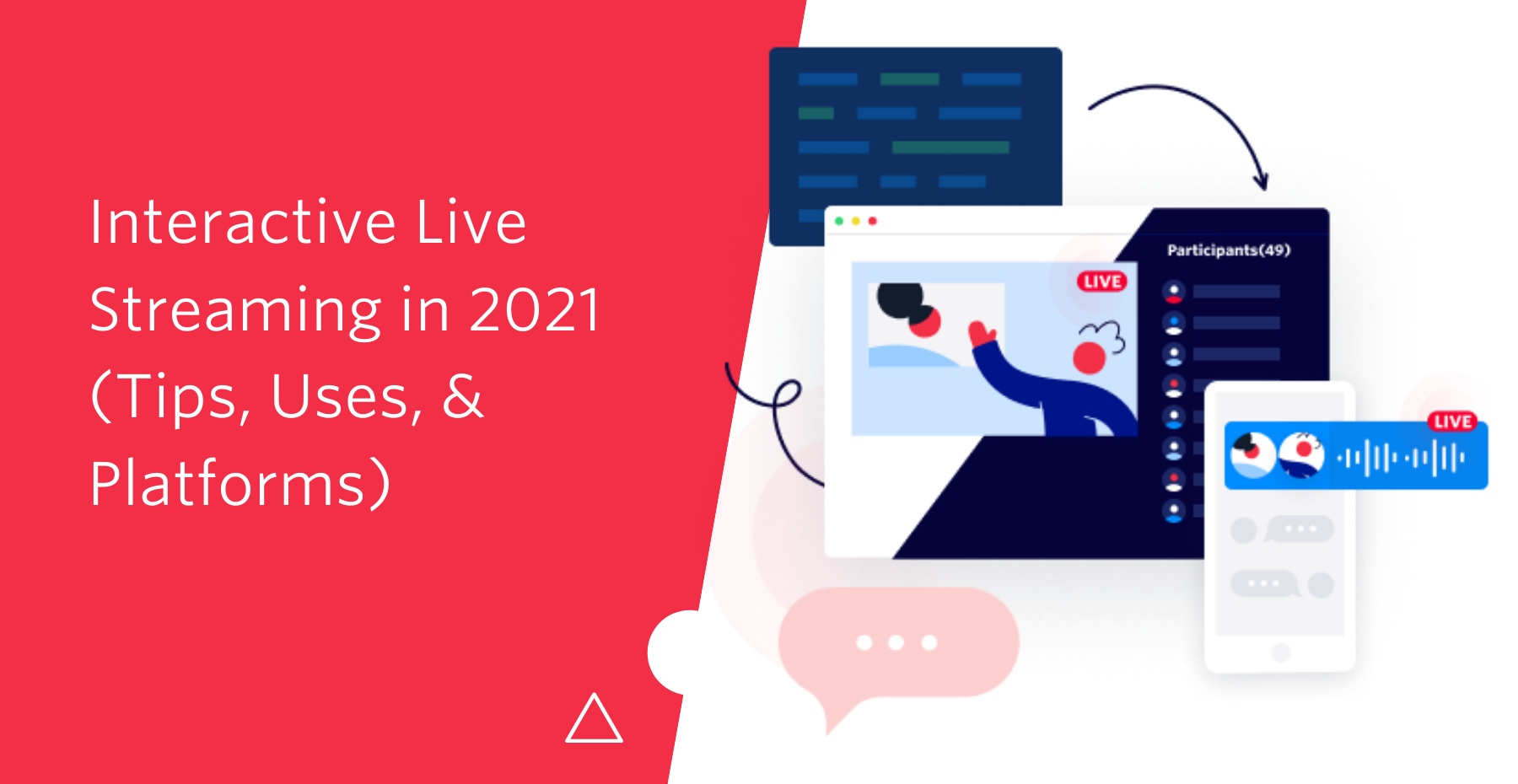Interactive Live Streaming in 2022 (Tips, Uses, & Platforms)
Time to read: 6 minutes

Live video streaming has been on the up-and-up in recent years—and 2020 only helped accelerate the movement. With physical distancing mandates and canceled events, more businesses went live online to connect with audiences virtually.
And it worked!
Live streaming helped businesses survive and thrive, and it doesn't look like it's going away anytime soon. Quite the opposite. Live streaming has gone from niche to mainstream, and just about every social media, fitness, video game, and music app is capitalizing on the opportunity.
However, streaming has had to adapt quickly to differentiate itself from traditional television—and it's done so with interactive live streaming. Audiences don't just sit and watch today's live streams—they interact. They chat, like, contribute, ask, vote, donate, win, and engage in novel ways over video and audio streams.
The industry is evolving quickly, and businesses are finding innovative ways to use live-streaming APIs to take their digital viewing experiences to the next level. From head-to-head Peloton group training to live virtual reality concerts, businesses are finding brand-new ways to add interactive live streaming to the customer engagement repertoire.
Below, we'll walk you through the benefits of live streaming and best practices for going live (from today's leading experts).
Benefits of live interactive streaming
With traditional video content like YouTube, Vimeo, and social media uploads, why should you go through the hassle of live streaming? Is it worth investing your time and resources?
Great questions. We have answers.
- Increase attention: Live-streamed content receives 27% more minutes of watch time (per viewing) versus on-demand video.
- Become an early adopter: The live video streaming industry grew 99% between April 2019 and April 2020. Now's the time to satisfy booming demand, with estimates showing 15-fold growth by 2022.
- Inspire action: Customers who watch live videos are more likely to take action. Viewers are 67% more likely to buy a ticket to an event or concert after watching a live video of that event, and 30% who watch a live stream of one event will attend the same event the next year.
- Drive revenue: Approximately 37% of China's online shoppers made a live-stream purchase in 2019. And live-stream sales are expected to grow to 9% of all online retail sales.
Live video is hot right now, and everyone from small businesses to big brands is getting in on the action. Influencers, musicians, and even local governments are finding new ways to take advantage of live streaming's popularity. From virtual town halls to online learning, there's a place for interactive video streaming in any business or app's communications program.
Below, we've outlined a few examples of how individuals are getting creative with live streaming. Use these ideas as a kicking-off point for your own program or as inspiration for your next big idea.
How to use interactive streaming (examples & ideas)
Social media platforms
You can go live on just about any social media channel: Facebook Live, Instagram Live, YouTube Live, and more. Some channels were built for the sole purpose of live streaming, like Twitch and Periscope.
These channels enable live consumption, encourage interactive participation with real-time chat and donations, and even let the audience buy the opportunity to speak live.
Events
Brands are now live streaming product launches, conferences, and other live events to drive awareness and sales. For example, we stream parts of Twilio SIGNAL (our annual developer conference) every year. Viewers can watch keynotes and product sessions, as well as join networking events, to engage and learn the latest about our offerings.
Online shopping
Individual brands are going online to showcase products and enable live-stream purchasing. Some are even joining virtual shopping malls, like Taobao Live, which lets customers shop and enjoy live entertainment at the same time. Enabling online shopping can be a great alternative revenue stream for physical retailers, especially during periods like the COVID-19 lockdown.
Virtual fitness
Peloton's bike isn't all that special—what's special about Peloton is its live and on-demand classes. Peloton's live-streaming classes put you head-to-head against other participants, making the workout a bit more interactive and challenging. You can see the progress of other members, giving you a bit more drive to push yourself.
Education and training
High schools and colleges went online last year, and it's a component of learning that looks like it'll continue. You can find streamers teaching everything from building apps with Python to showing you how to paint happy shrubs like Bob Ross. Professors can live stream lectures, giving participants the opportunity to ask questions, answer quizzes, and respond via real-time surveys. This new form of learning replaces on-demand videos and more closely replicates live in-person learning.
Entertainment
Concerts, sporting events, podcasts, and even your child's school play—more events are adding a live online component to expand viewership and participation. Some events have even added live 3D virtual reality elements to make you feel like you're actually there in person. We've even seen the popularity explosion of new apps like TikTok and Clubhouse.
Government procedures
Even the government is getting in on the live streaming action. From streaming the local town hall meeting to holding virtual courts of law, governments are going online to make information and processes more widely available. Yes, you can even get legally married virtually now.
Tips for live streaming
Hosting a successful stream isn't as simple as hitting the "go live" button—there's a lot of upfront preparation and in-stream know-how necessary to get it right. We talked to our Twilio streaming experts to give you a few behind-the-scenes streaming tips for knocking your next stream out of the park:
- Interact with your audience: Live streams are different from TV and movies. As the host and producer, it's your job to interact with participants. That could be as simple as enabling a chat, hosting a Q&A, shouting out names, and adding viewers to the stream.
- Find the right time: Your stream is live, so you need to be strategic about your timing. If you're live streaming a video gaming session, it might be more difficult to get viewers during the middle of the workday. However, if you wait until later in the evening, there's a better chance your audience will be available.
- Build the right setup: If you'd like to go all out with high-end tech and green screens, go right ahead. However, you can do just fine with a budget-friendly setup that includes a well-chosen, noise-free area and basic AV equipment.
- Check your bandwidth: You'll want to use a live-streaming solution that provides low-latency streaming, or else you won't be able to host high-quality live streams to audiences on a large scale.
- Choose your platform: Do your research to find the right platform for your audience. It might make more sense to build your video streams straight into your website and apps via APIs rather than hosting it on Twitch or YouTube Live. It'll also need to be compatible with iOS and Android devices.
- Improve every stream: After every stream, think about what happened. What went well? What didn't? Make changes to enhance your next stream so that each one is better than the last.
- Test, test, test: Experiment with everything before you go live. Ensure your AV equipment is working, the lighting looks good, and your background noise is at a minimum.
- Make a plan: Unless you're a famous Twitch streamer, you'll want a plan before you go live. What do you plan on showing, doing, or talking about? Do you have a backup plan in case something goes wrong or unexpected?
Think about the live stream audience interaction experience before you go live. This will ensure you're set up for success and ready to deliver a top-notch user experience.
Make it happen with the best live-streaming platform
While streaming is widely available today, not many solutions provide the right balance of interactive support, scalability, and security necessary to build top-notch live audio and video applications.
Until now.
Twilio Live is a developer-first platform that enables builders to add interactive audio and video streaming functionality to any application. Our best-in-class live-streaming platform provides flexible APIs, SDKs, and low latency at scale to help you build the app you need.
Here are the interactive components you can add to your streams:
- Turn on text-based chat
- Give your audience a voice with live polls
- Invite audience members “on stage” to speak
Interested in building interactive live streaming into your apps? Visit twilio.com/live to learn more about Twilio Live and request a beta invitation.
Related Posts
Related Resources
Twilio Docs
From APIs to SDKs to sample apps
API reference documentation, SDKs, helper libraries, quickstarts, and tutorials for your language and platform.
Resource Center
The latest ebooks, industry reports, and webinars
Learn from customer engagement experts to improve your own communication.
Ahoy
Twilio's developer community hub
Best practices, code samples, and inspiration to build communications and digital engagement experiences.


